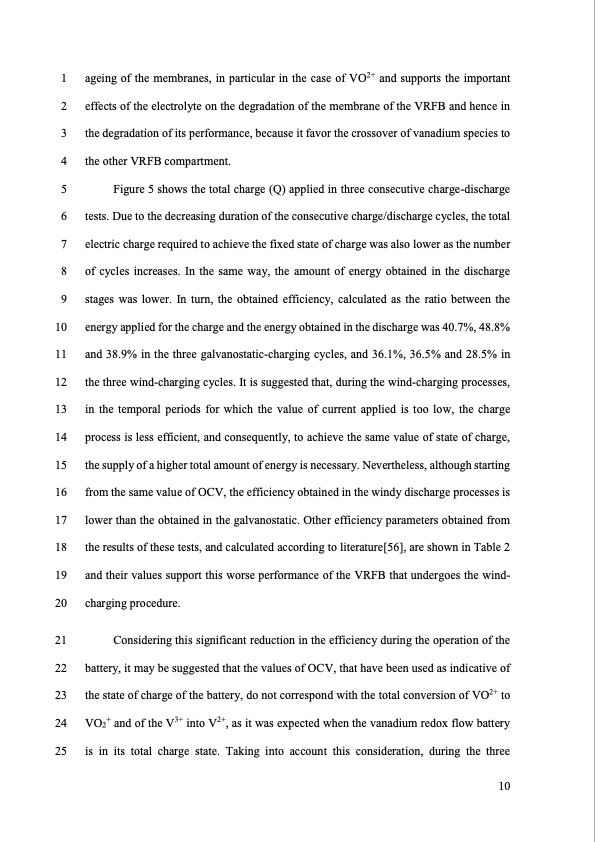
PDF Publication Title:
Text from PDF Page: 010
1 ageing of the membranes, in particular in the case of VO2+ and supports the important 2 effects of the electrolyte on the degradation of the membrane of the VRFB and hence in 3 the degradation of its performance, because it favor the crossover of vanadium species to 4 the other VRFB compartment. 5 Figure 5 shows the total charge (Q) applied in three consecutive charge-discharge 6 tests. Due to the decreasing duration of the consecutive charge/discharge cycles, the total 7 electric charge required to achieve the fixed state of charge was also lower as the number 8 of cycles increases. In the same way, the amount of energy obtained in the discharge 9 stages was lower. In turn, the obtained efficiency, calculated as the ratio between the 10 energy applied for the charge and the energy obtained in the discharge was 40.7%, 48.8% 11 and 38.9% in the three galvanostatic-charging cycles, and 36.1%, 36.5% and 28.5% in 12 the three wind-charging cycles. It is suggested that, during the wind-charging processes, 13 in the temporal periods for which the value of current applied is too low, the charge 14 process is less efficient, and consequently, to achieve the same value of state of charge, 15 the supply of a higher total amount of energy is necessary. Nevertheless, although starting 16 from the same value of OCV, the efficiency obtained in the windy discharge processes is 17 lower than the obtained in the galvanostatic. Other efficiency parameters obtained from 18 the results of these tests, and calculated according to literature[56], are shown in Table 2 19 and their values support this worse performance of the VRFB that undergoes the wind- 20 charging procedure. 21 Considering this significant reduction in the efficiency during the operation of the 22 battery, it may be suggested that the values of OCV, that have been used as indicative of 23 the state of charge of the battery, do not correspond with the total conversion of VO2+ to 24 VO2+ and of the V3+ into V2+, as it was expected when the vanadium redox flow battery 25 is in its total charge state. Taking into account this consideration, during the three 10PDF Image | Vanadium Redox Flow Batteries for wind turbines

PDF Search Title:
Vanadium Redox Flow Batteries for wind turbinesOriginal File Name Searched:
wind-turbine-flow-battery-storage.pdfDIY PDF Search: Google It | Yahoo | Bing
Salgenx Redox Flow Battery Technology: Salt water flow battery technology with low cost and great energy density that can be used for power storage and thermal storage. Let us de-risk your production using our license. Our aqueous flow battery is less cost than Tesla Megapack and available faster. Redox flow battery. No membrane needed like with Vanadium, or Bromine. Salgenx flow battery
| CONTACT TEL: 608-238-6001 Email: greg@salgenx.com | RSS | AMP |